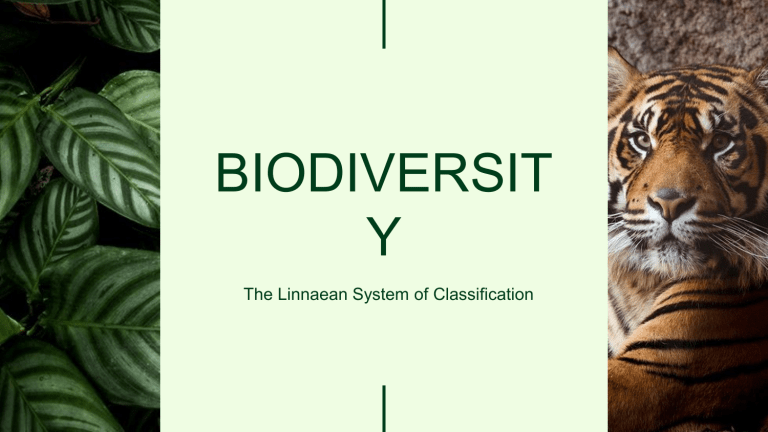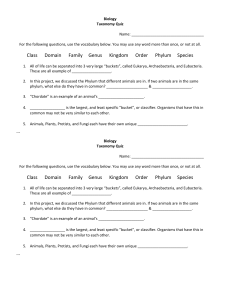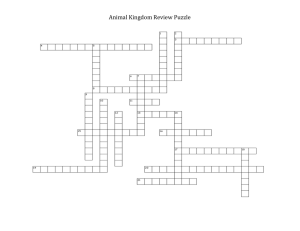
BIODIVERSIT Y The Linnaean System of Classification FOCUS POINTS 01 DESCRIBE THE LINNAEAN SYSTEM OF CLASSIFICATIO N 02 IDENTIFY THE LEVELS OF CLASSIFICATIO N 03 DESCRIBE THE BASIS USED IN GROUPING LIVING THINGS INTO THE SIX KINGDOM SCHEME OF CLASSIFICATIO N TAXONOMY - Is the science that deals with the naming, describing, and classifying of living things. CAROLUS VON LINNAEUS He is a Swedish botanist who introduced a system of classifying living things. There are two important features of his work: classification of living things by levels and the binomial nomenclature. Levels Composition Kingdom The highest and the most comprehensive level; a group of related phyla Phylum A group of related classes Class A group of related orders Order A group of related families Family A group of related genera Genus A group of related species Species A group of similar organisms capable of interbreeding and producing fertile offspring THE DIFFERENT LEVELS OF CLASSIFICATION Levels Classification Composition Kingdom Animalia Actively mobile, heterotrophic, multicellular and eukaryotic Phylum Chordata With two pairs of appendages and with a dorsal nerve cord that extends the entire length of its body. Class Vertebrata With backbone that supports and encloses the spinal cord Order Mammalia With a body covered with hair and breasts that are used by female in feeding its young Family Primate Erect – uses only the hind legs in walking Genus Homo Has humanlike features Species Sapiens Wise THE CLASSIFICATION OF MAN BINOMIAL NOMENCLATURE - It is the system of giving living things a two-part name, which is Latinized. It comprises the scientific name of the organism. Ex. Homo sapiens / H. sapiens / Homo sapiens Domain Domain is the largest category into which organisms are classified. Back then, organisms were only grouped into eukaryotes and prokaryotes. Then scientists came up with the three-domain systems of classification. Recently, prokaryotes have been divided into two domains namely: Archaea and Eubacteria. The eukaryote group was retained and includes the protists, fungi, plants, and animals. DOMAIN ARCHAEA Organisms of this kingdom are all microscopic, meaning we cannot see them with our unaided eyes. Archaebacteria has no nucleus and even organelles. Their genetic materials float freely in cytoplasm. They live and settle in diverse places, some even in the most extreme environments. Methanogens, halophiles, and thermophiles are examples of Archaebacteria. Methanogens can survive in places where there is little to no oxygen, like the digestive tracts of animals and ponds. An important characteristic of this group is they produce methane gas. Halophiles are adapted to very salty environments. Examples of halophiles are Haloccocus dombrowski and Halobacterium salinarium. Thermophiles can live in places with high temperature. These include volcanic hot springs with temperatures from 80 to 110˚C. DOMAIN EUBACTERIA Kingdom Eubacteria Members of Eubacteria are unicellular and microscopic. They do not have true nucleus and organelles and are regarded as the true bacteria. Their cell walls are made of peptidoglycan, the basic unit of the cell wall in bacteria, which confers mechanical rigidity to the cell, protects the cytoplasmic membrane and determines the cell form. Members of Domains Eubacteria and Archaebacteria are called prokaryotes because of they lack a true nucleus and membrane-bound organelles. EUBACTERIA VS ARCHAEBACTERIA DOMAIN EUKARYA Eukarya consists of organisms that have a true nucleus and structures called organelles that are surrounded with by membranes. Organisms in the domain Eukarya keep their genetic material in a nucleus and include the plants, animals, fungi, and protists. Kingdom Kingdom is the taxonomic rank after domain. In the late 18th century, studies of organisms resulted in only two-kingdom classification system. But with the invention of the microscope and with more evidences gathered about different forms of life, various scientists have proposed three to four, then five, and later six or even eight-kingdom classification. Here are the six-kingdom classification: Archaebacteria, Eubacteria, Protist, Fungi, Plant, and Animal kingdoms. DOMAIN EUKARYA: KINGDOM PROTISTA Members of Kingdom Protista come from unrelated ancestors thus, this grouping is referred to by biologists as an artificial grouping. They can be classified into three groups: plant-like, animal-like, and fungi-like protists. The grouping is based on their method of obtaining energy and ability to locomote. Photoautotrophs are like plants in that they have chlorophyll, and they can produce their own food through photosynthesis. This group includes the algae, dinoflagellates, and euglenoids. These protists are generally considered as plantlike. Some of them have the ability to locomote (locomotory) like dinoflagellates that can cause red tide, while others are non-locomotory like the algae. DOMAIN EUKARYA: KINGDOM PROTISTA Heterotrophs are those that obtain energy from organic matter by feeding on other organisms. These include radiolarians, foraminiferans and amoeba. Some heterotrophic protists can also locomote by means of pseudopodia, cilia, or flagella hence, they are referred to as animal-like protists because of their heterotrophic and locomotory nature. Examples of these include Amoeba which uses pseudopodia to locomote, Paramecium that uses cilia, and Trypanosoma that uses flagella. A group of protists called Sporozoa has members that are nonlocomotory because of the absence of any locomotory structure. An example of this is Plasmodium, four species of which are known causative agents of malaria. DOMAIN EUKARYA: KINGDOM PROTISTA The third group of protists are the fungilike protists that are classified based on their similarity in characteristics to fungi in that they reproduce by forming spores and are considered as saprotrophic. Saprobes or saprotrophs are organisms that derive energy from organic matter, hence, they are considered as heterotrophs, but they perform extracellular digestion by releasing enzymes into dead organic matter and absorbing the products of digestion. Examples of this are slime molds and water molds. Both are known decomposers in their habitats. DOMAIN EUKARYA: KINGDOM FUNGI Fungi are eukaryotic, non-vascular, non-motile and heterotrophic organisms. They may be unicellular or filamentous. They reproduce by means of spores and exhibit the phenomenon of alternation of generation. Fungi lack chlorophyll and hence cannot perform photosynthesis. Volvariella sp. (paddy straw mushroom) and Pleurotus sajor caju (oyster mushroom) are examples of edible fungi. Yeast is the type of fungi which exist as the single cell, reproduce asexually, and are used in food, beverages, etc. On the other hand, molds are multicellular with hyphae that makes the vegetative form of the fungus called mycelium and may function for the absorption of nutrients. They can reproduce sexually or asexually; used in making antibiotics, and cheese, etc. DOMAIN EUKARYA: KINGDOM FUNGI The fungi help in decomposing organic matter, play a big part in material biodegradation, and enable recycling of materials in all ecosystems. The enzymes and mycotoxins can also inhibit the growth of other molds and microorganisms. Decomposition is made faster using Trichoderma harzianum. An important mold to mention is Penicillium notatum, which is used in making penicillin, a drug that kills disease-causing bacteria. DOMAIN EUKARYA: KINGDOM PLANTAE You knew earlier that plants belong to the eukaryote group. They are multicellular and because they have chlorophyll, they can make their own food. Plants consist of two big groups: those which do not have tissues to transport water and food (nonvascular) and those that have such transport system (vascular). Some examples of vascular plants include maize, mustard, rose, cycad, ferns, clubmosses, grasses, etc. Some examples of non-vascular plants include moss, liverwort, and hornwort GYMNOSPERMS These are seed plants composed of those which bear seeds contained in cones and those inside a protective layer of tissue. Plants with seeds borne in cones are called gymnosperms. Examples of gymnosperms are the conifers (e.g., Pine trees, cypresses), cycads, ginkgoes, and gnetophytes. ANGIOSPERMS They are also called flowering plants since flowers, as well as fruits, are involved in their reproduction and development. DOMAIN EUKARYA: KINGDOM ANIMALIA Animals are divided in two major groups, the invertebrates and vertebrates. Invertebrates are those that do not possess a vertebral column or backbone while vertebrates are those where vertebral column or backbone is present. Vertebrates: Phylum Chordates Animals that belong to Phylum Chordata have four characteristics that are present in any stages in their life cycle. These are the notochord, the dorsal hollow nerve cord, gill slits, and a post-anal tail. Notochord serves as a source of midline signals that pattern surrounding tissues and as a major skeletal element of the developing embryo. Vertebrates: Phylum Chordates : Fishes Fishes can be classified into either Class Osteichthyes or Class Chondricthyes. Include Chondrichthyes is a class of jawed fishes having a cartilaginous skeleton. The class includes a diverse group of fishes including sharks, rays, skates, and chimaeras. They are mostly marine fishes. The other group of fishes are bony fishes, which are included in the class Osteichthyes. These are cold-blooded animals with backbone and are found in either saltwater or freshwater. Most possess scales for protection, a paired fin for movement and gills for gas exchange. Fishes may lay eggs to reproduce or give birth to live young. Vertebrates: Phylum Chordates : Amphibians Class Amphibia refers to cold-blooded animals that live part in water and part on land, from which amphibians got their name. Most lay small, shell-less eggs surrounded by jellylike substance in wet places or in water. These hatch into larvae with gills and tails. The species in this group include frogs, toads, salamanders, and newts. All can breathe and absorb water through their very thin skin. Amphibians also have special skin glands that produce useful proteins. Vertebrates: Phylum Chordates : Reptilians Class Reptilia include cold-blooded animals that exhibit more adaptations for living on land. They lay eggs with shells to protect them from drying up. They even have smooth or rough scales that cover their body to minimize loss of water. Some reptiles have smooth scales like lizards and snakes, while others have rough scales like crocodiles and alligators. Alligators live in freshwater and are only found in North and South America. They include crocodiles, snakes, lizards, turtles, and tortoises. Vertebrates: Phylum Chordates : Birds Birds belong to Class Aves, and most are adapted to fly. Their adaptation for flight includes wings and feathers, large flight muscles attached to their breastbone, and reduced bone weight. Some birds are warm-blooded, while others are cold-blooded. Flightless birds are birds which cannot fly. They rely on their ability to run or swim and have evolved from their flying ancestors. These are Penguin, Ostrich, Kiwi, Kakapo and Cassowary. Vertebrates: Phylum Chordates : Mammals Class Mammalia differ from other animals because they have mammary glands that produce milk to nourish their young and most have hair or fur. They inhale air, have fourchambered hearts and are warmblooded. Most of them also give birth to live young and care for them (Campo et al. 2013, 228264). Invertebrates: Phylum Porifera : Sponges The simplest animals belong to Phylum Porifera. They live in shallow and deep oceans. The young of sponges are motile, while adults are attached to solid materials like rocks. The body of a hard sponge is supported by a “skeleton” composed of spicules, that are made of glasslike silica or calcium carbonate. A network of protein fibers supports soft sponges. This is the one used for bathing and washing. Invertebrates: Phylum Cnidaria : Cnidarians Members of Phylum Cnidaria consist of animals whose tentacles contain stinging cells called nematocysts. These poison-filled structures are used for defending themselves and for capturing their prey and food. Once released, this poison can be painful to their enemies. Examples of these are jellyfish or sea jellies, corals, and sea anemones. Corals forms colonies of various colors and secrete a hard skeleton. These accumulate to form coral reefs which are of great importance as they are one of the most worlds most productive ecosystem. Invertebrates: Phylum Platyhelminthes : Flatworms The belong to Phylum Platyhelminthes (in Greek platys means flat, helmins means worm). As their names suggest, they are flat and ribbonlike organisms. Flatworms are found in freshwater, in wet places and marine waters. They include the freeliving or nonparasitic worms, the parasitic flukes, and the tapeworms group. Planaria is an example of a free-living flatworms. Tapeworms are parasitic flatworms like flukes with incomplete digestive system. Invertebrates: Phylum Nematoda : Roundworms These are members of Phylum Nematoda. Compared to flatworms, roundworms, also known as nematodes, have long, cylindrical, and slender bodies. A roundworm has a complete digestive system, which includes both a mouth and an anus. This is a significant difference from the incomplete digestive system of flatworms. The roundworm digestive system also includes a large digestive organ known as the gut. Digestive enzymes that start to break down food are produced here. There is no stomach, but there is an intestine which produces enzymes that help absorb nutrients. The last portion of the intestine forms a rectum, which expels waste through the anus. Example of roundworms. Ascaris lumbricoides (also called human roundworm), which is the most common roundworm infection, and affects as many as one billion people worldwide. Invertebrates: Phylum Annelida : Segmented Worms The third group of worms among the animal phyla belongs to Phylum Annelida, also called annelids. These worms are characterized by a segmented or repeated body parts which enable them to move easily with flexibility. Segmented worms include the common earthworm and leeches. They have a digestive system, nervous system, and circulatory system. Invertebrates: Phylum Mollusca : Gastropods; Bivalves; Cephalopods These soft-bodied invertebrates are mostly covered with shells. They have complex respiratory, reproductive, circulatory, digestive, and excretory systems functioning together for their survival. Mollusks consists of three classes: The Gastropods, Bivalves and Cephalopods. Gastropods, also called univalves and has only one shell. They are mostly marine and freshwater and terrestrial members. Bivalves are mollusks consists of two shells attached to each other. Some bivalves are attached to rocks while others remain in the sand or mud. The cephalopod group includes the squid and cuttlefish with internal skeleton. The chambered nautilus has external skeleton while the octopus is shell-less. Invertebrates: Phylum Echinodermata :Echinoderms Diverse marine invertebrates that include sea urchins, sand dollars, star fish, sea cucumbers and brittle stars. They are recognizable by their pentameric radial symmetry. They have a star-like appearance and are spherical or elongated. They are exclusively marine animals and organisms are spiny-skinned. They also exhibit organ level of organization. Examples of an echinoderm include a starfish, a sand dollar, a brittle star, a sea urchin, and a sea cucumber. Invertebrates: Phylum Anthropoda :Anthropods Invertebrates: Arthropods Phylum Arthropoda is considered the most successful of all animal phyla as they are present in almost all types of habitats. Arthropods walk or crawl, some can fly, while others swim in salty and freshwaters. They have segmented body with a head, a thorax, and abdomen segments. Appendages on at least one segment. A nervous system and a hard exoskeleton made of chitin, which gives them physical protection and resistance to drying out. Examples of arthropods are Chelicerata: horseshoe crabs, spiders, scorpions, sea spiders and mites. Myriapoda: millipedes, centipedes, pauropods and symphylans (known as glasshouse symphylans or garden centipedes) Crustacea: brine shrimp, barnacles, lobsters, crabs, shrimp and remipedes. Examples of How Organisms are Classified Category Domestic Cat Dog Bangus Malunggay Pineapple Domain Eukarya Eukarya Eukarya Eukarya Eukarya Kingdom Animalia Animalia Animalia Plantae Plantae Phylum Chordata Chordata Chordata Vascular Magnioliophyta Class Mammalia Mammalia Actinopterygii Dicotyledon Monocotyledon Order Carnivora Carnivora Gonorynchiformis Brassicales Poales Family Felidae Canidae Chanidie Moringaceae Bromeliaceae Genus Felis Canis Chanos Moringa Ananas Species catus familiaris chanos oliefera comosus

